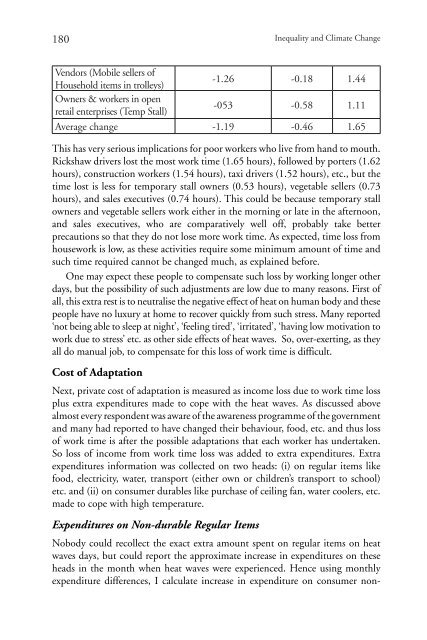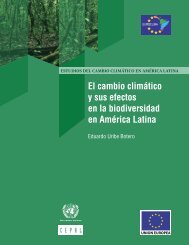Inequality and Climate Change Inégalité et changement climatique
Inequality
Inequality
You also want an ePaper? Increase the reach of your titles
YUMPU automatically turns print PDFs into web optimized ePapers that Google loves.
180<br />
<strong>Inequality</strong> <strong>and</strong> <strong>Climate</strong> <strong>Change</strong><br />
Vendors (Mobile sellers of<br />
Household items in trolleys)<br />
-1.26 -0.18 1.44<br />
Owners & workers in open<br />
r<strong>et</strong>ail enterprises (Temp Stall)<br />
-053 -0.58 1.11<br />
Average change -1.19 -0.46 1.65<br />
This has very serious implications for poor workers who live from h<strong>and</strong> to mouth.<br />
Rickshaw drivers lost the most work time (1.65 hours), followed by porters (1.62<br />
hours), construction workers (1.54 hours), taxi drivers (1.52 hours), <strong>et</strong>c., but the<br />
time lost is less for temporary stall owners (0.53 hours), veg<strong>et</strong>able sellers (0.73<br />
hours), <strong>and</strong> sales executives (0.74 hours). This could be because temporary stall<br />
owners <strong>and</strong> veg<strong>et</strong>able sellers work either in the morning or late in the afternoon,<br />
<strong>and</strong> sales executives, who are comparatively well off, probably take b<strong>et</strong>ter<br />
precautions so that they do not lose more work time. As expected, time loss from<br />
housework is low, as these activities require some minimum amount of time <strong>and</strong><br />
such time required cannot be changed much, as explained before.<br />
One may expect these people to compensate such loss by working longer other<br />
days, but the possibility of such adjustments are low due to many reasons. First of<br />
all, this extra rest is to neutralise the negative effect of heat on human body <strong>and</strong> these<br />
people have no luxury at home to recover quickly from such stress. Many reported<br />
‘not being able to sleep at night’, ‘feeling tired’, ‘irritated’, ‘having low motivation to<br />
work due to stress’ <strong>et</strong>c. as other side effects of heat waves. So, over-exerting, as they<br />
all do manual job, to compensate for this loss of work time is difficult.<br />
Cost of Adaptation<br />
Next, private cost of adaptation is measured as income loss due to work time loss<br />
plus extra expenditures made to cope with the heat waves. As discussed above<br />
almost every respondent was aware of the awareness programme of the government<br />
<strong>and</strong> many had reported to have changed their behaviour, food, <strong>et</strong>c. <strong>and</strong> thus loss<br />
of work time is after the possible adaptations that each worker has undertaken.<br />
So loss of income from work time loss was added to extra expenditures. Extra<br />
expenditures information was collected on two heads: (i) on regular items like<br />
food, electricity, water, transport (either own or children’s transport to school)<br />
<strong>et</strong>c. <strong>and</strong> (ii) on consumer durables like purchase of ceiling fan, water coolers, <strong>et</strong>c.<br />
made to cope with high temperature.<br />
Expenditures on Non-durable Regular Items<br />
Nobody could recollect the exact extra amount spent on regular items on heat<br />
waves days, but could report the approximate increase in expenditures on these<br />
heads in the month when heat waves were experienced. Hence using monthly<br />
expenditure differences, I calculate increase in expenditure on consumer non-





